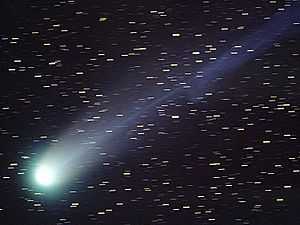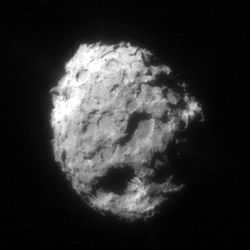C/1989 X1
| Discovery | |
|---|---|
| Discovered by | Rodney R. D. Austin |
| Discovery date | 6 December 1989 |
| Alternative designations | 1990 V, 1989c1 |
| Orbital characteristics A | |
| Perihelion | 0.3497735 AU |
| Eccentricity | 1.0002278 |
| Inclination | 58.95559° |
| Last perihelion | 9 April 1990 |
C/1989 X1 (Austin) (old-style designations 1990 V and 1989c1) was a comet discovered by New Zealand amateur Rodney R. D. Austin on December 6, 1989. By the time of its discovery, it was already obvious that it must be an unusually large object. At that time the comet was still more than 350 million kilometres from the Sun and yet it was so bright that it was seen as an 11th magnitude object (that is, 1/100 as bright as what can be perceived with the unaided eye).
More observations were soon made, establishing the comet's orbit, and it was found that it will pass through its perihelion (the point of its orbit where it is closest to the Sun) on 9 April 1990 at a distance of about 53 million kilometres, inside the orbit of Mercury, the planet closest to the Sun.
Thereafter it will move outwards again and, by good luck, it will come within 38 million kilometres of the Earth on May 25. It will be well situated in the sky for observation from the northern hemisphere after 20 April 1990 when it can be seen low above the NW horizon, just after sunset, and even better above the NE horizon, shortly before sunrise. It is expected that Comet Austin will then have developed a tail which should be easily observable and provide spectators with a grand celestial view.[1]
References
- ↑ "ESO - eso9004 - Comet Austin Develops a Long Tail". ESO. Retrieved 2010-01-11.
External links
- C/1989 X1 at the JPL Small-Body Database

